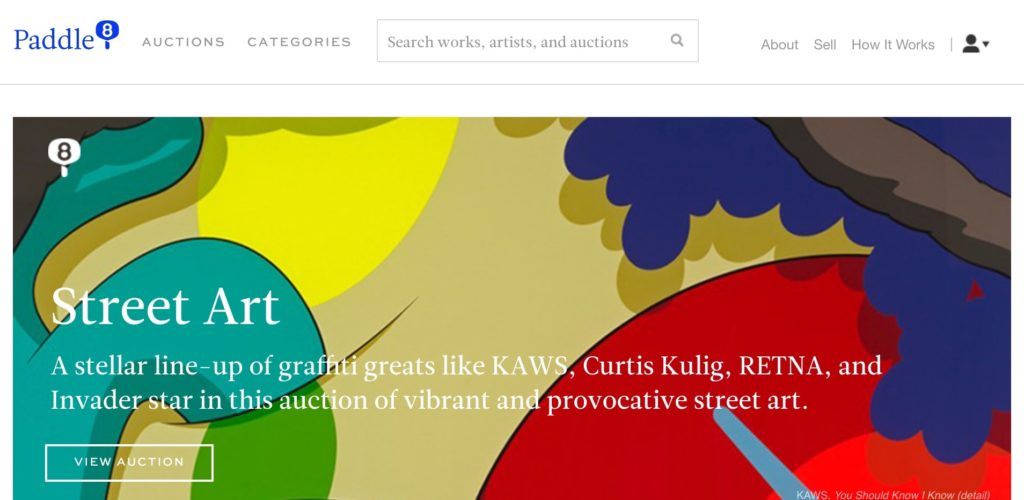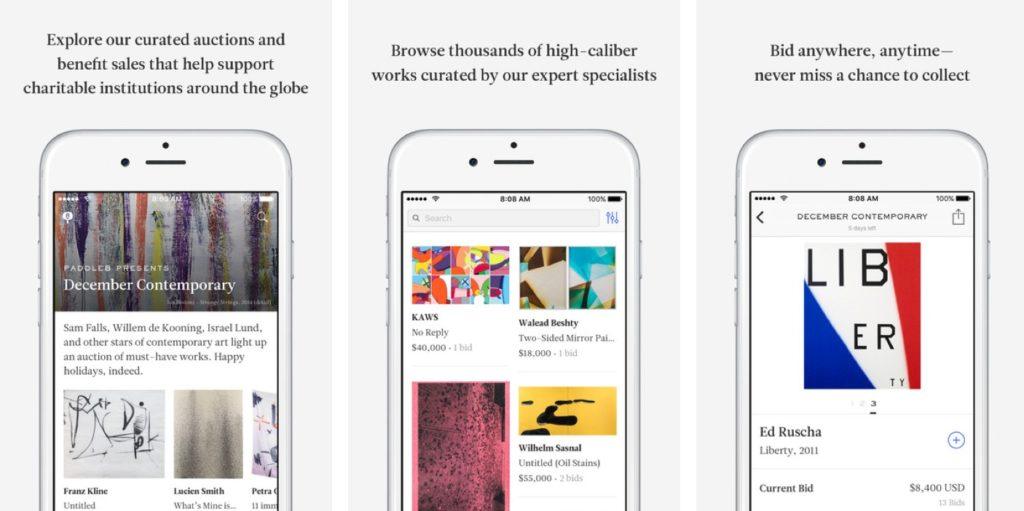Paddle8 is taking art auctions online

Paddle8's online efforts are reducing prices, speeding up service and democratising auctions
Founded in 2011, Paddle8 is an online auction house that enables a globally dispersed audience to access artworks and collectables. It occupies the mid-market space between mass marketplaces like eBay, that don’t always deliver taste and trust, and Sotheby’s and Christie’s, which have historically focused on higher end pieces.[1] Prices fall between $1,000 to $100,000, with most sales occurring in the $5,000 to $15,000 range.[2]
This market has traditionally been served by regional auction houses, where both buyers and sellers face high costs and cumbersome processes. Whilst selling art online might feel like an obvious move for the art world, the channel is still very much in its infancy in this context. 5 years ago, the prevailing attitude was that art was never going to be sold online. However, in 2015 online art market sales reached $3.27 billion, up 24% from 2014, and this growth is set to continue.[3]
Low, transparent prices and fast service
Traditional auction houses add consignor’s commissions, buyer’s premiums and other transaction-related fees atop the lot “price”, which sum to high and opaque fees for individuals on both sides of the transaction. In contrast, Paddle8 charges a flat 20% premium to the buyer and 8% to the seller, which is clear, consistent, and considerably lower than the industry standard.[4] They can also auction and deliver a lot to its buyer in 4-6 weeks, compared with 6-9 months at brick and mortar houses.[5] This is achieved by digitising and automating their operations, reducing costs by 50-70%[6] vs. these traditional players and increasing agility.
For example, sellers can take photos of potential consignments and send them to Paddle8’s valuations team via its app. If entered for auction, a work will not leave a seller’s home until it is sold. Instead, high resolution images are taken and uploaded to Paddle8’s website for viewing by potential buyers. This avoids the need for high cost gallery space and glossy catalogues whilst reducing shipping and inventory costs.
Furthermore, marketing is automated using a database of collectors. Algorithms determine their preferences based on the artists who they “follow” on the website, their “watched items” and past bidding behaviour. They are then alerted if the work of, or related to, a preferred artist is coming up for auction. Once a successful bid has been accepted, Paddle8 automates all billing, invoicing and other administrative processes. Insurance, shipping, and installation services are also available to purchase via the online platform.
Ease of access
The largely analogue operations of traditional auction houses mean that consumers are highly localised, reducing their addressable market size. Paddle8’s online platform means that buyers from around the world have instant access to their auctions. Not only can they see detailed images of art works online, but they can submit maximum bids at any time (much like eBay). The founders claim that this can increase the prices achieved by 30%.[7]
The offline art world can also feel intimidating and opaque to “outsiders” interested in collecting. Accessing the market via the internet democratises this process, welcoming new collectors with a simple sign up process. Indeed, 45% of respondents surveyed for Hiscox’s 2015 Art Trade Report admitted that buying from an online art platform feels less intimidating than buying from a physical gallery or auction house. [8]
The way forward
Whilst Paddle8 has been a force for significant innovation, there is a competitive threat from the nascent online efforts of Sotheby’s and Christie’s, plus an array of over 50 other digital art businesses to contend with. Besides M&A activity, Paddle8 must find innovative ways to build market share and overcome the fact that 48% of online buyers still prefer viewing art in galleries.[10]
The online sales channel tends to work better for art that is a known quantity, such as prints, photographs or works by a popular artist. It isn’t as effective at selling three-dimensional works such as installations or sculpture, which are hard to truly appreciate through photographs. Paddle8 could work to overcome this by using augmented reality to bring artworks into a customer’s home. They could also consider a limited returns policy, although this would be risky for the business.
Physical art events are also valued by many collectors. The best gallerists and auctioneers can add a sense of theatre and glamour to openings and auctions, which translates into sales. Paddle8 might consider introducing select in-person auction events, executed in a modern fashion and streamed online, to capture a similar sense of excitement around their brand. (743 words)
Footnotes
[1] http://www.worth.com/paddle8/
[2] Ibid.
[3] https://www.hiscox.co.uk/online-art-trade-report/docs/hiscox-online-art-trade-report-2016-v2.pdf
[4] https://paddle8.com/
[5] http://www.bloomberg.com/news/videos/2015-04-07/how-paddle8-is-helping-to-bring-the-art-world-online
[6] Ibid.
[7] http://www.worth.com/paddle8/
[8] https://www.hiscox.co.uk/online-art-trade-report/docs/hiscox-online-art-trade-report-2016-v2.pdf
[9] https://pressfolios-production.s3.amazonaws.com/uploads/story/story_pdf/168549/1685491447095277.pdf
[10] https://www.hiscox.co.uk/home-insurance/cover-stories/old-versus-new-in-the-ever-evolving-art-markets/





What an interesting concept! I worry about Paddle8’s ability to scale, however, since in-person authentication has long been a central piece of the auction process. Indeed, in my opinion, even work from known artists can only really be experienced—and rightly valuated at thousands and thousands of dollars—if the buyers and the experts can stand with their noses nearly touching the surface, experiencing the texture of the paint, the bend of the sculpture, the composition in full. I question whether any online photograph or digital screen can truly replace the immediate thrill of seeing and judging great art.
Assuming that hi-def does indeed replace in-person viewing, however, I also worry about the famous auction houses simply swooping into the space and clobbering Paddle8. After all, the strength of the Sotheby’s name will make authenticated art only more valuable in the marketplace. What is it that Paddle8 has that is genuinely unique or ownable?
Thanks for the post Beth!
While reading through the Digital Transformation articles, it seems like there are two categories of digital transformation that most companies employ: 1) as an avenue for cost-reduction and optimization and 2) as a way to democratize an entire industry. Paddle8 is a great example of the latter category. The problem with being that latter category though, as Kiernan mentions above as well, is being substantially different enough that competitors don’t come in swathes. After all, democratizing an industry means breaking down barriers to entry and I guess, the key is to break down barriers for your key constituents (buyers and sellers in this case) while putting up barriers so that those same constituents don’t have a reason to leave your platform!
Thanks Beth, so excited to read a post on my favorite auction-house! Let me know when the Arts Club is planning to visit them!
Online salesrooms are certainly the way forward for the lower and middle parts of the art market (<$100k) as buyers are increasingly nomadic, craving convenience and immediacy, and relatively cost sensitive. This is a great choice of topic to showcase how important digital is to a startup's business model. Democratic luxury sounds like an oxymoron. And yet, as the sub $100k market hones in on sophisticated technological innovations and operational structures to accommodate high volume, automated shipping and insurance, and remote consignments, Paddle8 positions itself very separately from traditional high-end auction-houses. In addition, the online model provides significant cost efficiencies and savings (eliminating the middle-man, shipping costs, printing of physical catalogues and prime real estate) which are then passed on to the buyer and seller.
Regardless of the online medium, the physical experience is still key to providing the drama of an evening sale. To address this, the startup has been investing early on in tangible experiences and destinations by collaborating with monthly guest curators such as Grace Coddington (http://modafamilia.com/news/grace-coddington-curates) or Robin Williams, who increase emotional engagement by taking over the site entirely (https://techcrunch.com/2012/02/08/founder-collective-makes-a-4-million-bet-on-paddle8s-online-marketplace-for-fine-art/.). Pop up showrooms are also in the works.